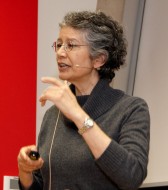E-mail: michael.kiebler(at)med.uni-muenchen.de
Research Group: www.zellbio.anatomie.med.uni-muenchen.de/about_us/prof_kiebler
Institution: LMU Munich, Department for Cell Biology (Head of Dept)
Member of the DoktoratsKolleg RNA Biology from 2007 until 2013.
Member of the Focus Regulatory RNA (SFB RNA-REG) from 2011 until 2013.
Michael Kiebler moved to LMU Munich in 2012 to head there the newly founded Department for Cell Biology.
DK PhD alumni:
Jacki Heraud: “Functional characterisation of novel neuronal Staufen2 target RNAs”
Foong yee Ang: “Biochemical characterization of Staufen2-, Barentsz- and Pumilio2-containing neuronal ribonucleoprotein particles from rat brain“
E-mail: kazufumi.mochizuki(at)imba.oeaw.ac.at
Institution: previously at IMBA until end of 2016, then:
Kazufumi Mochizuki & his group moved to IGH Montpellier
Full member of the DoktoratsKolleg RNA Biology since 2007 until 2016.
Full member of the Focus Regulatory RNA (SFB RNA-REG) from 2011 until 2015.
PhD students within/associated to the DK:
Quentin Rahms
DK RNA Alumni:
Sophie Soyka: “Characterization of a novel gene from Tetrahymena thermophila involved in RNA directed DNA elimination”
Jan Henrik Suhren: “Small RNA-directd heterochromatin formtion in Tetrahymena thermophila”
Ursula Schöberl: “RNA-directed DNA elimination in Tetrahymena thermophila”
Research:
Transgenerational epigenetic inheritance has been observed in a wide variety of eukaryotes from plants to mammals while its molecular mechanism is still unclear. Our group studies such an epigenetic inheritance process that regulates programmed DNA elimination in the ciliated protozoan Tetrahymena. Nuclear-acting small RNAs mediate the communication between the parental and gremlin genomes and we try to understand how these small RNAs are utilized to establish the epigenetic inheritance.

E-mail: dbarlow(at)cemm.oeaw.ac.at
Research Group: www.cemm.oeaw.ac.at
Institution: CeMM
Full member of the DoktoratsKolleg RNA Biology from 2007 until 2013.
Full member of the Focus Regulatory RNA (SFB RNA-REG) from 2011 until 2015.
DK RNA Biology Alumni:
Daniel Andergassen: “Mapping the mouse Allelome reveals tissue-specific regulation”
Alexandra Kornienko: “Identification and variabilitiy analysis of long non-coding RNAs in human primary granulocytes”
Tomasz Kulinski: “Genomic imprinting in mouse extra-embryonic cell lineage in vitro and in vivo”
Federica Santoro: “Onset and maintenance of Airn non-coding RNA mediated imprinted expression in an in vitro embryonic stem cell model”
Philipp Günzl: “Macro lncRNA hallmarks analyzed by RNAseq”
Genomic imprinting – an entry point for the unexpected:
All mammals including human beings inherit equal numbers of genes from both their parents, but about 200 of these are ‘imprinted’ by one parent. The consequences of this is that although we have two parental copies of imprinted genes only one copy can be turned on, while the other is locked in a silent state. The study of imprinted genes has uncovered many unpredictable findings about what controls the on/off state of a gene. In particular, the Barlow lab has shown that a special class of inefficiently-spliced long non-coding RNA, known as a ‘macro’ ncRNA, act in cis to initiate silencing of imprinted genes. The human genome is known to contain vast numbers of long ncRNAs that are presumed to play a gene-regulatory role. The Barlow lab is now using RNA-seq combined with a recently developed pipeline to optimize the identification of the whole coding and non-coding transcriptome in mammalian cells, to study the role of long and macro ncRNAs in development and disease.
E-mail: andrea.barta(at)meduniwien.ac.at
Phone: 0043 1 4277 61640
Research website: www.maxperutzlabs.ac.at/education/lecturers/barta
Institution: May Perutz Labs/MedUniWien
Speaker of the DoktoratsKolleg (DK) RNA Biology since 2007 and member of the Focus Regulatory RNA (SFB RNA Reg) from 2011 to 2015.
PhD students within/associated to the DK:
Manali MISHRA
Katarina RADISAVLJEVIC (co-supervised by Alwin Köhler)
DK RNA Biology alumni & their PhD theses:
Olga BANNIKOVA: “Finding RNA targets for the multidomain cyclophilin AtCyp59 by Genomic SELEX in Arabidopsis thaliana”
Janett GÖHRING: “Imaging of Endogenous mRNA Splice Variants in Living Plant Cells”
Yamile MARQUEZ ORTIZ: “Identification of Alternative Splicing Events in Arabidopsis thaliana: Regulation by abiotic stress and plant specific SR proteins”
Armin FUCHS: “Unraveling the role of the plant-specific Ser/Arg-rich proteins RS31 and RS31a in alternative splicing and the DNA damage response in Arabidopsis thaliana”
Our research:
What determines the complexity of higher organisms? No correlation has been found to DNA content and gene number and therefore studies in the field are now focusing on post-transcriptional processes and the impact of the dynamic transcriptome on gene expression.
Alternative splicing is one of the posttranscriptional events to expand the repertoire of genes and it has been exploited for various differentiation processes. In plants, the significance of alternative splicing was long underestimated, but we and others have shown that it greatly impacts on development and response to the environment. As alternative splicing in Arabidopsis is not well defined we are using RNAseq to define the rules and targets of alternative splicing.
SR (Ser/Arg) proteins are important splicing factors and to date we have isolated and partially characterized several Arabidopsis SR proteins, which are important for splice site selection and spliceosome assembly. In addition, we have isolated several regulatory proteins which seem to be essential to drive the splicing process, like SRPK kinases, helicases and cyclophilins. To elucidate their mechanisms of action some of the plant SR proteins and cyclophilins are currently characterized in greater detail in terms of their RNA targets, interacting proteins and their impact on flowering and UV-stress response. Interestingly, some of these factors seem to connect splicing to transcription and are therefore currently investigated in greater detail.
Furthermore, a project has been started to investigate the influence of chromatin and DNA modifications on alternative splicing in plants. In another line of research, we are developing a genomic method to select for riboswitches (these are regulatory RNA elements which can bind metabolites) in plants, as they are implicated in regulating alternative splicing and gene expression.
Publications: (since 2011)
The Cyclin Dependent Kinase G group defines a thermo-sensitive alternative splicing circuit modulating the expression of Arabidopsis ATU2AF65A.
Cavallari N, Nibau C, Fuchs A, Dadarou D, Barta A, Doonan JH.
Plant J. 2018 Mar 30.
RNA in Disease and development.
Barta A, Jantsch MF.
RNA Biol. 2017 May 4;14(5):457-459.
doi: 10.1080/15476286.2017.
A high quality Arabidopsis transcriptome for accurate transcript-level analysis of alternative splicing.
Zhang R, Calixto CP, Marquez Y, Venhuizen P, Tzioutziou NA, Guo W, Spensley M, Entizne JC, Lewandowska D, Ten Have S, Frei Dit Frey N, Hirt H, James AB, Nimmo HG, Barta A, Kalyna M, Brown JW.
Nucleic Acids Res. 2017 Apr 11.
The spliceosome-associated protein Nrl1 suppresses homologous recombination-dependent R-loop formation in fission yeast.
Aronica L, Kasparek T, Ruchman D, Marquez Y, Cipak L, Cipakova I, Anrather D, Mikolaskova B, Radtke M, Sarkar S, Pai CC, Blaikley E, Walker C, Shen KF, Schroeder R, Barta A, Forsburg SL, Humphrey TC.
Nucleic Acids Res. 2016 Feb 29;44(4):1703-17.
Lost in Translation: Pitfalls in Deciphering Plant Alternative Splicing Transcripts.
Brown JW, Simpson CG, Marquez Y, Gadd GM, Barta A, and Kalyna M
Plant Cell. 2015 Aug;27(8):2083-7.
Unmasking alternative splicing inside protein-coding exons defines exitrons and their role in proteome plasticity.
Marquez Y, Höpfler M, Ayatollahi Z, Barta A, Kalyna M.
Genome Res. 2015 Jul;25(7):995-1007.
AtRTD – a comprehensive reference transcript dataset resource for accurate quantification of transcript-specific expression in Arabidopsis thaliana.
Zhang R, Calixto CP, Tzioutziou NA, James AB, Simpson CG, Guo W, Marquez Y, Kalyna M, Patro R, Eyras E, Barta A, Nimmo HG, Brown JW.
New Phytol. 2015 Jun 25.
Suitable transfection methods for single particle tracing in plant suspension cells.
Göhring J, Fulcher N, Schilcher K, Barta A, Jacak J.
Plant Methods. 2014 May 31;10:15.
A chloroplast retrograde signal regulates nuclear alternative splicing.
Petrillo E, Godoy Herz MA, Fuchs A, Reifer D, Fuller J, Yanovsky MJ, Simpson C, Brown JWS, Barta A, Kalyna M, Kornblihtt AR
Science. 2014 Apr 25;344(6182):427-30.
Imaging of endogenous messenger RNA splice variants in living cells reveals nuclear retention of transcripts inaccessible to nonsense-mediated decay in Arabidopsis.
Göhring J, Jacak J, Barta A.
Plant Cell. 2014 Feb;26(2):754-64.
Suitable transfection methods for single particle tracing in plant suspension cells.
Göhring J, Fulcher N, Schilcher K, Barta A, Jacak J.
Plant Methods. 2014 May 31;10:15.
Shedding light on the chloroplast as a remote control of nuclear gene expression.
Godoy Herz MA, Kornblihtt AR, Barta A, Kalyna M, Petrillo E.
Plant Signal Behav. 2014;9(11):e976150.
Let there be light: regulation of gene expression in plants.
Petrillo E, Godoy Herz MA, Barta A, Kalyna M, Kornblihtt AR.
RNA Biol. 2014;11(10):1215-20
Complexity of the alternative splicing landscape in plants.
Reddy AS, Marquez Y, Kalyna M, Barta A.
Plant Cell. 2013 Oct;25(10):3657-83.
Introns of plant pri-miRNAs enhance miRNA biogenesis.
Bielewicz D, Kalak M, Kalyna M, Windels D, Barta A, Vazquez F, Szweykowska-Kulinska Z, Jarmolowski A.
EMBO Rep. 2013 Jul;14(7):622-8.
Identification of RNA targets for the nuclear multidomain cyclophilin atCyp59 and their effect on PPIase activity.
Bannikova O, Zywicki M, Marquez Y, Skrahina T, Kalyna M, Barta A.
Nucleic Acids Res. 2013 Feb 1;41(3):1783-96.
Alternative splicing in plants–coming of age.
Syed NH, Kalyna M, Marquez Y, Barta A, Brown JW.
Trends Plant Sci. 2012 Oct;17(10):616-23.
Transcriptome survey reveals increased complexity of the alternative splicing landscape in Arabidopsis.
Marquez Y, Brown JW, Simpson C, Barta A, Kalyna M.
Genome Res. 2012 Jun;22(6):1184-95.
Alternative splicing and nonsense-mediated decay modulate expression of important regulatory genes in Arabidopsis.
Kalyna M, Simpson CG, Syed NH, Lewandowska D, Marquez Y, Kusenda B, Marshall J, Fuller J, Cardle L, McNicol J, Dinh HQ, Barta A, Brown JW.
Nucleic Acids Res. 2012 Mar;40(6):2454-69.
Localization and dynamics of nuclear speckles in plants.
Reddy AS, Day IS, Göhring J, Barta A.
Plant Physiol. 2012 Jan;158(1):67-77.
